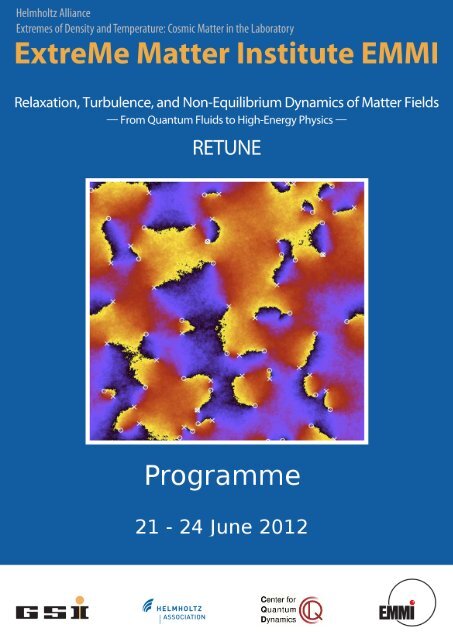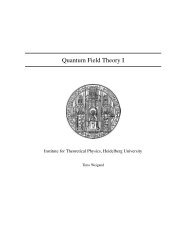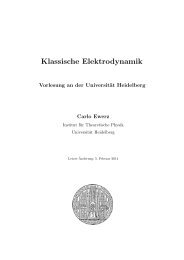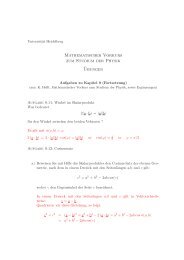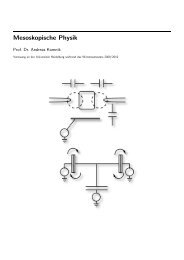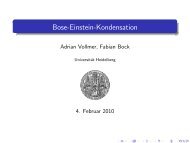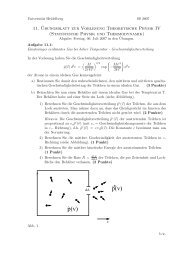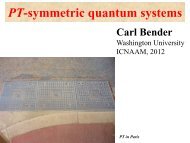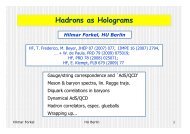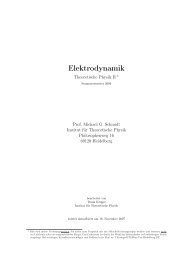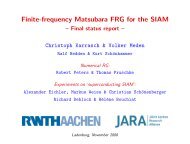Turbulence and Bose Condensation - Institut für Theoretische ...
Turbulence and Bose Condensation - Institut für Theoretische ...
Turbulence and Bose Condensation - Institut für Theoretische ...
Create successful ePaper yourself
Turn your PDF publications into a flip-book with our unique Google optimized e-Paper software.
text<br />
2
Programme<br />
Wednesday, 20 June 2012<br />
19:00 Welcome reception at the International Science Forum<br />
Thursday, 21 June<br />
09:00 Opening<br />
09:20 Joe Vinen (Birmingham) An Introduction to Superfluidity<br />
<strong>and</strong> Quantum <strong>Turbulence</strong><br />
10:10 Carlo Barenghi (Newcastle) Quantum Vortices <strong>and</strong> Their<br />
Reconnections<br />
10:50 Coffee/Tea<br />
11:40 Makoto Tsubota (Osaka) Quantum hydrodynamics <strong>and</strong><br />
turbulence in <strong>Bose</strong>-Einstein<br />
Condensates<br />
12:20 Gregory Falkovich (Rehovot) Phase transitions in turbulence<br />
13:00 Lunch<br />
14:30 Ulrich Heinz (Columbus) "Perfect fluidity" in relativistic<br />
heavy-ion collisions<br />
15:10 Elena Bratkovskaya (Frankfurt) Off-shell dynamical approach for<br />
relativistic Heavy-Ion Collisions<br />
15:50 Coffee/Tea<br />
16:30 Jean-Paul Blaizot (Saclay) Thermalization of the quark-gluon<br />
plasma<br />
17:10 Jürgen Berges (Heidelberg) <strong>Turbulence</strong> <strong>and</strong> <strong>Bose</strong> <strong>Condensation</strong>:<br />
From the Early Universe to Cold<br />
Atoms<br />
17:50 Evening at free disposition<br />
3
Friday, 22 June<br />
09:00 Carlo Ewerz (EMMI) The ExtreMe Matter <strong>Institut</strong>e<br />
09:20 Christof Wetterich (Heidelberg) Prethermalization<br />
10:10 Igor Tkachev (Moscow) <strong>Turbulence</strong> in the Early Universe<br />
10:50 Coffee/Tea<br />
11:40 Kerson Huang (Cambridge/Singapore) A Superfluid Universe<br />
12:20 Alberto Amo (Paris) Superfluidity <strong>and</strong> hydrodynamic<br />
excitations in out of equilibrium<br />
polariton condensates<br />
13:00 Lunch<br />
14:30 Johanna Stachel (Heidelberg) The ALICE experiment at LHC<br />
(prelim.)<br />
15:20 Brian Anderson (Tucson) Two-dimensional quantum<br />
turbulence in <strong>Bose</strong>-Einstein<br />
condensates<br />
16:00 Matthew Davis (Queensl<strong>and</strong>) Nonequilibrium <strong>Bose</strong> gases with<br />
c-fields<br />
16:40 Coffee/Tea<br />
17:10 Andrei Golov (Manchester) <strong>Turbulence</strong> in Superfluid 4 He in the<br />
T = 0 Limit<br />
17:50 Michiel Wouters (Antwerpen) c-field descriptions of<br />
nonequilibrium polariton<br />
condensates<br />
18:30 Dinner buffet <strong>and</strong> Posters<br />
4
Saturday, 23 June<br />
09:00 Sergej Demokritov (Münster) Ground state <strong>and</strong> excitations (vortices<br />
<strong>and</strong> sound waves) in a <strong>Bose</strong>-<br />
Einstein condensate of magnons<br />
09:50 Jonathan Keeling (St. Andrews) <strong>Condensation</strong>, superfluidity <strong>and</strong><br />
lasing of coupled light-matter<br />
systems<br />
10:30 Hiromitsu Takeuchi (Hiroshima) Tachyon <strong>Condensation</strong> in<br />
<strong>Bose</strong>-Einstein Condensates<br />
10:50 Coffee/Tea<br />
11:40 Vladimir Eltsov (Aalto) <strong>Bose</strong>-Einstein condensation of<br />
magnons in superfluid 3 He-B <strong>and</strong><br />
its applications to vortex studies<br />
12:20 Sergey Nazarenko (Warwick) Wave <strong>Turbulence</strong> in <strong>Bose</strong>-Einstein<br />
Condensates<br />
13:00 Lunch<br />
14:30 Gora Shlyapnikov (Orsay) Novel physics with polar molecules<br />
15:20 Kenji Fukushima (Keio) Instability in an exp<strong>and</strong>ing<br />
non-Abelian system<br />
16:00 Anton Rebhan (Wien) Nonabelian plasma instabilities<br />
16:30 Coffee/Tea<br />
17:00 Excursion<br />
20:00 Conference dinner<br />
5
Sunday, 24 June<br />
09:30 V<strong>and</strong>erlei Bagnato (Sao Carlos) Quantum turbulence in an atomic<br />
trapped superfluid: the observation<br />
of a power law in the kinetic energy<br />
spectrum<br />
10:10 George Pickett (Lancaster) tba<br />
10:50 Discussion Session<br />
11:30 Coffee/Tea<br />
11:50 Boris Nowak (Heidelberg) Nonthermal fixed points <strong>and</strong><br />
superfluid turbulence<br />
12:30 Jörg Schmiedmayer (Wien) Relaxation in an Isolated Quantum<br />
System<br />
13:10 Lunch <strong>and</strong> Closing<br />
6
Practical Information<br />
The local participants will wear a green sticker on their name tag. They will<br />
answer any practical questions you may have.<br />
Location<br />
The conference hall is in the Internationales Wissenschaftsforum Heidelberg (IWH),<br />
situated in the old town of Heidelberg at the foot of the castle hill. The address<br />
is the following:<br />
Internationales Wissenschaftsforum Heidelberg<br />
Hauptstrasse 242<br />
D-69117 Heidelberg<br />
The public transport station that is closest is “S-Bahnhof Altstadt”. It can be<br />
reached with the S-Bahn (lines S1 <strong>and</strong> S2) or the bus (line 33). Then it’s a 3<br />
minutes walk in direction of the city centre to reach the IWH.<br />
The nearest parking opportunities are "Parkhaus 13" at the "Karlsplatz" (16 €<br />
per day) <strong>and</strong> "Parkhaus 12" at the "Kornmarkt" (12,- € per day). It is a 3-minute<br />
walk from there to the IWH.<br />
For more information, please look up the local public transportation <strong>and</strong> German<br />
railway Internet pages:<br />
http://www.vrn.de<br />
http://www.bahn.com<br />
Transportation to <strong>and</strong> from Frankfurt airport can be found at:<br />
http://www.transcontinental-group.com/en/frankfurt-airport-shuttles/<br />
https://www.tls-heidelberg.de/en/<br />
There is also map with many useful annotations at:<br />
http://g.co/maps/jt46s<br />
7
Internet<br />
There is a wifi Internet access in the conference hall. Connect to WLAN ’UNI-<br />
WEBACCESS’ <strong>and</strong> open your browser. It will automatically redirect to the login<br />
page.<br />
login: iq3<br />
password: 8x7du<br />
The web-page of the conference is:<br />
http://www.thphys.uni-heidelberg.de/ smp/RETUNE2012/index.php<br />
It contains additional information about the conference. We will try to assemble<br />
the material of the conference <strong>and</strong> make it available on the web-page as well.<br />
8
Talks<br />
9
An Introduction to Superfluidity <strong>and</strong> Quantum<br />
<strong>Turbulence</strong><br />
William (Joe) Vinen<br />
School of Physics <strong>and</strong> Astronomy, University of Birmingham, Birmingham B15<br />
2TT, United Kingdom<br />
Superfluids, formed in the liquid phases of the isotopes of helium <strong>and</strong> in very cold<br />
gases, are characterised by the presence of a coherent particle field, associated<br />
with <strong>Bose</strong> or BCS condensation, the behaviour of which is described in weakly<br />
interacting systems by a non-linear Schrodinger equation. As a result there are<br />
interesting links with other systems. Simple superfluids display two-fluid effects,<br />
a normal fluid coexisting with a superfluid component. Flow of the superfluid<br />
component is constrained by the phase coherence of the particle field, so that<br />
only irrotational flow is possible, with a quantized circulation <strong>and</strong> quantized<br />
vortex filaments. The quantised vortex filaments allow forms of turbulence in<br />
the superfluid component. Some of these forms have features that are similar to<br />
those encountered in classical viscous fluids; others are quite different, allowing,<br />
for example, turbulence in a fluid in which there is no viscous dissipation or in<br />
which either both fluids or two co-existing superfluids are involved.<br />
10
Quantum Vortices <strong>and</strong> Their Reconnections<br />
Carlo Barenghi<br />
School of Mathematics <strong>and</strong> Statistics, Newcastle University, Herschel Building,<br />
Newcastle upon Tyne NE1 7RU, United Kingdom<br />
In superfluid helium <strong>and</strong> atomic <strong>Bose</strong>-Einstein condensates, any rotational motion<br />
is strongly affected by quantum mechanical constrains; the vorticity, which in<br />
ordinary fluids is a smooth, continuous field, takes the form of discrete vortex<br />
filaments. I shall describe recent results in the study of vortex reconnections <strong>and</strong><br />
turbulence, paying particular attention to the comparison between quantum <strong>and</strong><br />
ordinary turbulence, <strong>and</strong> finite temperature effects in atomic condensates.<br />
Quantum hydrodynamics <strong>and</strong> turbulence in<br />
<strong>Bose</strong>-Einstein Condensates<br />
Makoto Tsubota<br />
Department of Physics, Osaka City University, Sugimoto 3-3-138, Sumiyoshi-ku<br />
558-8585, Japan<br />
Quantum hydrodynamics <strong>and</strong> turbulence have been studied in the field of superfluid<br />
helium, while it is currently studied in atomic <strong>Bose</strong>-Einstein condensates<br />
(BECs). A general introduction to this issue <strong>and</strong> a brief review of the basic<br />
concepts are followed by the recent developments in these topics. We will discuss<br />
quantum turbulence in two-component BECs, <strong>and</strong> spin turbulence in spinor<br />
BECs etc.<br />
11
Phase transitions in turbulence<br />
Gregory Falkovich<br />
Weizmann <strong>Institut</strong>e of Science, Rehovot, Israel<br />
We consider states far from thermal equilibrium within the Gross-Pitaevsky<br />
model. We focus on the inverse cascade at low wavenumbers/momenta, which<br />
feeds the condensate. We show that the condensate growth leads to a series of<br />
phase transitions accompanied by the change of symmetries.<br />
12
"Perfect fluidity" in relativistic heavy-ion<br />
collisions<br />
Ulrich Heinz<br />
Physics Department, The Ohio State University, 191 West Woodruff Avenue,<br />
OH 43210-1117, Columbus, USA<br />
The Quark-Gluon Plasma QGP created in heavy-ion collisions at the Relativistic<br />
Heavy Ion Collider (RHIC) <strong>and</strong> the Large Hadron Collider (LHC) has been called<br />
a "perfect liquid". It exhibits the collective dynamic behaviour of a fluid with<br />
almost vanishing viscosity. Theory places lower limits on the shear <strong>and</strong> bulk viscosities<br />
of any real (i.e. not super-)fluid, <strong>and</strong> the QGP shear viscosity appears to<br />
be close to that limit. Recent progress on the modeling side of heavy-ion collision<br />
dynamics has put the quantitative determination of the QGP shear viscosity<br />
from experimentally measaured hadron spectra <strong>and</strong> anisotropic flow coefficients<br />
within reach. I will present new limits on the kinematic shear viscosity of QGP<br />
extracted from VISHNU, a hydrodynamic code that couples a viscous fluid description<br />
of the dense QGP phase with a microscopic Boltzmann cascade for the<br />
dilute late hadron resonance gas stage, in comparison with elliptic <strong>and</strong> triangular<br />
flow data from RHIC <strong>and</strong> LHC. As will be discussed, event-by-event fluctuations<br />
of the initial shape <strong>and</strong> density distribution in the QGP fireball <strong>and</strong> the resulting<br />
anisotropic flow play a crucial role in this extraction.<br />
13
Off-shell dynamical approach for relativistic HIC<br />
Elena Bratkovskaya<br />
<strong>Institut</strong>e <strong>für</strong> <strong>Theoretische</strong> Physik <strong>and</strong> Frankfurt <strong>Institut</strong>e for Advanced Studies,<br />
Johann Wolfgang Goethe University, Ruth-Moufang-Str. 1, 60438 Frankfurt am<br />
Main, Germany<br />
We present a conceptually novel approach - derived from Kadanoff-Baym equations<br />
in phase-space representation - for the dynamical description of the strongly<br />
interacting Quark-Gluon-Plasma (sQGP) including a dynamical hadronization<br />
scheme, i.e. the Parton-Hadron-String Dynamics (PHSD) transport approach<br />
which has been successfully applied for the description of heavy-ion collisions<br />
from lower FAIR to LHC energies. The PHSD model reproduces a large variety<br />
of observables (e.g. as quark-number scaling of elliptic flow, transverse mass <strong>and</strong><br />
rapidity spectra of charged hadrons, dilepton spectra, collective flow coefficients<br />
etc.) which are associated with the observation of a sQGP. This transport model<br />
provides a solid tool to study the new stage of matter (sQGP) from a microscopic<br />
point of view incorporating the information from lattice QCD calculations<br />
in equilibrium.<br />
Thermalization of the quark-gluon plasma<br />
Jean-Paul Blaizot<br />
IphT, Sarclay, France<br />
14
<strong>Turbulence</strong> <strong>and</strong> <strong>Bose</strong> <strong>Condensation</strong>: From the<br />
Early Universe to Cold Atoms<br />
Jügen Berges<br />
<strong>Institut</strong>e for Theoretical Physics, Heidelberg University, Philosophenweg 16,<br />
69120 Heidelberg, Germany<br />
The ExtreMe Matter <strong>Institut</strong>e<br />
Carlo Ewerz<br />
ExtreMe Matter <strong>Institut</strong>e EMMI, GSI Helmholtzzentrum <strong>für</strong><br />
Schwerionenforschung, Planckstr. 1, D-64291 Darmstadt, Germany<br />
15
Prethermalization<br />
Christof Wetterich<br />
Inst. Theoretical Physics, University of Heidelberg, Philosophenweg 16, 69120,<br />
Heidelberg, Germany<br />
<strong>Turbulence</strong> in the Early Universe<br />
Igor Tkachev<br />
INR, Moscow, Russia<br />
Universe reheating after Inflation will be discussed, with the emphasis on <strong>Turbulence</strong><br />
<strong>and</strong> associated phenomena.<br />
16
A Superfluid Universe<br />
Kerson Huang<br />
MIT/<strong>Institut</strong>e of Advanced Studes, Nanyang Technological University, 60<br />
Nanyang View #02-18, Nanyang, USA/Singapore 639673<br />
Particle physics tells us that the vacuum is a dynamic medium possibly filled with<br />
complex scalar fields. Condensed matter physics tells us that a complex scalar<br />
field, whatever its origin, serves as order parameter for superfluidity. Considering<br />
the implication of all this on a cosmic scale, one comes to the conclusion that the<br />
universe may be a superfluid. We describe the emergence of such a superfluidity<br />
during the big bang, in terms of a mathematical initial-value problem based on<br />
Einstein’s equation. This is made possible by using the Halpern-Huang scalar<br />
potential, which is asymptotically free. The solution shows that the universe<br />
exp<strong>and</strong>s with accelerating rate, with an equivalent cosmological constant that<br />
decays in time according to a power law, <strong>and</strong> this gives dark energy without the<br />
usual fine-tuning problem. The dynamics of quantized vorticity allows the growth<br />
<strong>and</strong> decay of a superfluid vortex tangle (quantum turbulence), in which vortex<br />
reconnections can create all the matter present in the universe. The inflation era<br />
is the lifetime of quantum turbulence, according to this model. As for the present<br />
universe, the energy density of the superfluid is dark energy, <strong>and</strong> deviation of the<br />
superfluid from uniformity, due to the prescence of galaxies, is observed as dark<br />
matter, through gravitational lensing. Vortices surviving from the Planck era had<br />
core diameters growing from Planck length to the order of 108 light years. These<br />
giant vortex cores could explain the galactic voids now observed. Vortex reconnections<br />
generate two opposite jets of energy, which could explain cosmic jets.<br />
A collapsing rotating black hole in the superfluid would be covered with "hair"<br />
in the form of vortex filaments, which could explain the "non-thermal filaments"<br />
seen near the center of the Milky Way.<br />
17
Superfluidity <strong>and</strong> hydrodynamic excitations in<br />
out of equilibrium polariton condensates<br />
Alberto Amo<br />
Laboratoire de Photonique et Nanostructures, CNRS, Route de Nozay, 91460<br />
Marcoussis, France<br />
Exciton-polaritons are composite bosons arising from the strong coupling between<br />
quantum well excitons <strong>and</strong> photons confined in a semiconductor microcavity.<br />
They can be easily created by optical excitation <strong>and</strong> form extended bosonic condensates<br />
at relatively high temperatures (10-300 K). Their mixed matter-light<br />
nature provides polaritons with unprecedented properties: from their exciton<br />
component they inherit strong particle interactions giving rise to a number of<br />
non-linear phenomena, while their partly photonic origin gives rise to a very low<br />
mass (10-5 the free electron mass) <strong>and</strong> a short lifetime (a few picoseconds) due<br />
to the continuous escape of photons out of the microcavity. For this reason, polariton<br />
condensates present strong out-of-equilibrium features, their steady state<br />
being determined by the interplay between optical pumping, relaxation <strong>and</strong> decay.<br />
Here we will show experiments on the transition from a superfluid phase to<br />
shockwaves, vortex <strong>and</strong> soliton formation when a polariton condensate encounters<br />
a potential barrier in its flowpath at different Mach numbers. We will show<br />
that these phenomena present novel features arising from the out-of-equilibrium<br />
nature of polaritons, allowing the study of driven-dissipative quantum hydrodynamic<br />
phenomena not accessible in other kind of bosonic condensates.<br />
18
The ALICE experiment at LHC (prelim.)<br />
Johanna Stachel<br />
Physikalisches <strong>Institut</strong>, Universität Heidelberg, Im Neuenheimer Feld 226,<br />
Heidelberg, Germany<br />
Two-dimensional quantum turbulence in<br />
<strong>Bose</strong>-Einstein condensates<br />
Brian Anderson<br />
College of Optical Sciences, University of Arizona, 1630 E University Blvd, AZ<br />
85750, Tucson, USA<br />
The experimental <strong>and</strong> theoretical tools of atomic-gas <strong>Bose</strong>-Einstein condensates<br />
(BECs) are enabling rapid development of an underst<strong>and</strong>ing of two-dimensional<br />
quantum turbulence (2DQT) in compressible superfluids. For example, using<br />
highly oblate BECs, numerous experimental methods can be used to generate<br />
disordered distributions of quantized vortices that can be associated with 2DQT,<br />
<strong>and</strong> new vortex detection <strong>and</strong> manipulation techniques are emerging. In conjunction<br />
with this experimental progress, analytical <strong>and</strong> numerical efforts are uncovering<br />
new aspects regarding the vortices involved in 2DQT, from their dynamics<br />
to their relationships with energy spectra. This talk will focus on the physics of<br />
quantized vortices in 2DQT, particularly with respect to the common goals of<br />
experimental, numerical, <strong>and</strong> analytical efforts with condensates. We will give an<br />
overview of our recent findings on these topics, <strong>and</strong> will emphasize current <strong>and</strong><br />
upcoming experimental capabilities regarding 2DQT <strong>and</strong> vortex studies in BECs.<br />
With such research, we hope to discover new insights into the broad topics of<br />
superfluid turbulence <strong>and</strong> vortex dynamics.<br />
19
Nonequilibrium <strong>Bose</strong> gases with c-fields<br />
Matthew Davis<br />
School of Mathematics <strong>and</strong> Physics, University of Queensl<strong>and</strong>, St Lucia,<br />
Queensl<strong>and</strong> 4072, Australia<br />
The mean-field Gross-Pitaevskii equation has proven to be an excellent description<br />
of many experiments involving the dynamics of <strong>Bose</strong>-Einstein condensates.<br />
However, different theoretical formalisms can result in a similar equation of motion<br />
for a classical field that can be applied to degenerate <strong>Bose</strong> gases at finite<br />
temperatures near the critical point, <strong>and</strong> even the quantum dynamics near zero<br />
temperature. In this talk we will provide an introduction to these c-field techniques<br />
for <strong>Bose</strong> gases, <strong>and</strong> briefly describe nonequilibrium applications. These<br />
include the dynamics of condensate formation, <strong>and</strong> the determination of the superfluid<br />
fraction at finite temperature, as well as the dynamics of an engineered<br />
quantum phase transition in a two-component <strong>Bose</strong> gas at zero temperature.<br />
20
<strong>Turbulence</strong> in Superfluid 4He in the T=0 Limit<br />
Andrei Golov<br />
School of Physics <strong>and</strong> Astronomy, University of Manchester, Oxford Road,<br />
Manchester M13 9PL, UK<br />
In superfluid 4He, vorticity is confined to atomically-thin cores of quantized vortex<br />
lines. In a laminar flow, vortex lines preserve their identity (no reconnections).<br />
In contrast, a tangle of vortex lines in a turbulent flow is subject to frequent<br />
reconnections that r<strong>and</strong>omize the tangle, allow its topology to relax <strong>and</strong> feed<br />
the cascade of energy towards larger wavenumbers. At low temperatures, the<br />
dissipative lengthscales are as small as several nanometers; turbulence can hence<br />
span a huge range of lengthscales. At temperatures T = 1K, the energy cascade<br />
reaches quantum lengthscales at which the discrete nature of vorticity is important;<br />
here small vortex rings <strong>and</strong> Kelvin waves on individual vortex lines become<br />
key players. Different dynamics are expected for tangles of different structures<br />
<strong>and</strong> energy spectra that can be created by different means of driving turbulence.<br />
Recent experimental advances will be reviewed. Our means of driving turbulence<br />
included: rotational acceleration (either one-off or AC) of a cube-shaped container,<br />
coalescence of a beam of vortex rings, electrostatic forcing of a vortex<br />
tangle through negative ions trapped on vortex cores. Detection of turbulence<br />
was achieved through probing the density of vortex lines by micron-size charged<br />
vortex rings <strong>and</strong> monitoring the transport of trapped ions, sensitive to vortex<br />
reconnections <strong>and</strong> fluctuations of flow velocity. The following observations will<br />
be presented <strong>and</strong> discussed: the dynamics <strong>and</strong> free decay of turbulence with<br />
either classical (dominated by the large-scale flow) or quantum (dominated by<br />
the tension of quantized vortex lines) energy spectra, transition from laminar to<br />
turbulent flow for either a cloud of polarized vortex rings or an array of rectilinear<br />
vortex lines in rotation, fine structure (Kelvin waves <strong>and</strong> small vortex rings) of a<br />
vortex tangle at quantum lengthscale.<br />
21
c-field descriptions of nonequilibrium polariton<br />
condensates<br />
Michiel Wouters<br />
Universiteit Antwerpen, Universiteitsplein 1, 2610 Antwerpen (Wilrijk), Belgium<br />
Ground state <strong>and</strong> excitations (vortices <strong>and</strong> sound<br />
waves) in a <strong>Bose</strong>-Einstein condensate of<br />
magnons<br />
Sergej Demokritov<br />
<strong>Institut</strong>e for Applied Physics, University Münster, Corrensstr. 2-4, 48149<br />
Münster, Germany<br />
22
<strong>Condensation</strong>, superfluidity <strong>and</strong> lasing of coupled<br />
light-matter systems<br />
Jonathan Keeling<br />
School of Physics <strong>and</strong> Astronomy, University of St Andrews, St Andrews Fife<br />
KY16 9SS, St Andrews, United Kingdom<br />
The great experimental progress in realising <strong>and</strong> studying polariton condensates<br />
has made it possible to now study experimentally a number of fundamental<br />
questions about the relation between lasing, condensation, coherence <strong>and</strong><br />
superfluidity. In my talk, I will discuss the consequences of finite particle lifetime<br />
on several of these questions. In particular I will discuss how pattern formation<br />
in a non-equilibrium condensate is strongly affected by finite particle lifetime<br />
[1]. I will also address aspects of superfluidity [2], reviewing the results that<br />
have been seen so far, <strong>and</strong> proposing an alternate approach to clearly define<br />
the superfluid properties of a polariton condensate. As the polariton system is<br />
intrinsically two dimensional, I will also discuss how the power law correlations expected<br />
in two dimensions are modified by finite particle lifetime <strong>and</strong> finite size [3].<br />
[1]J. Keeling <strong>and</strong> N. G. Berloff, Phys. Rev. Lett 100, 250401 (2008); M. O.<br />
Borgh, G. Franchetti, J. Keeling, <strong>and</strong> N. G. Berloff, Phys. Rev. B, in press<br />
(2012)<br />
[2] J. Keeling, Phys. Rev. Lett. 107 080402 (2011)<br />
[3] G. Roumpos et al, Proc. Nat. Acad. Sci 109, 6467 (2012); J. Keeling, M.<br />
H. Szymanska, <strong>and</strong> P. B Littlewood, p 293 in Optical Generation <strong>and</strong> Control<br />
of Quantum Coherence in Semiconductor Nanostructures, eds. by G. Slavcheva<br />
<strong>and</strong> P. Roussignol (2010)<br />
23
Tachyon <strong>Condensation</strong> in <strong>Bose</strong>-Einstein<br />
Condensates<br />
Hiromitsu Takeuchi<br />
Hiroshima University, Hiroshima, Japan<br />
Brane cosmology proposes that the Big Bang occurs when a pair of a brane <strong>and</strong><br />
an anti-brane annihilate each other on collision. A phase transition accompanied<br />
with a spontaneous symmetry breaking occurs <strong>and</strong> consequently formations of<br />
lower- dimensional topological defects, e.g. cosmic strings, are inevitable. Such<br />
a phase transition is triggered by the so-called "tachyon condensation", where<br />
the existence of the tachyon is a consequence of the instability of the system.<br />
Here we show that the tachyon condensation by a pair annihilation of a brane<br />
<strong>and</strong> an anti-brane can be prepared in a laboratory experiment of atomic <strong>Bose</strong>-<br />
Einstein condensates. In this system, formations of vortices from domain-wall<br />
annihilations in three dimensions are understood as kink formations in a twodimensional<br />
phase ordering dynamics. This study provides insights into how the<br />
presence of the extra dimensions influences to a phase transition confined in a<br />
restricted space embedded in higher dimensions.<br />
24
<strong>Bose</strong>-Einstein condensation of magnons in<br />
superfluid 3He-B <strong>and</strong> its applications to vortex<br />
studies.<br />
Vladimir Eltsov<br />
O.V. Lounasmaa Laboratory, Aalto University, PO BOX 15100, 00076 AALTO,<br />
Finl<strong>and</strong><br />
In superfluid 3He-B traps for magnon excitations can be formed by the orderparameter<br />
texture <strong>and</strong> the applied profile of the static magnetic field. At temperatures<br />
around 0.2Tc <strong>and</strong> below one can pump magnons to the trap using NMR<br />
techniques to create macroscopic occupation of the ground or of a selected excited<br />
level. Such magnons form <strong>Bose</strong>-Einstein condensates as demonstrated by<br />
the long-lived coherent spin precession after switching off the pumping. The<br />
orbital texture is flexible <strong>and</strong> as the magnon occupation number increases the<br />
profile of the trap gradually changes from harmonic to a square well, with walls<br />
almost impenetrable to magnons. This is the first experimental example of <strong>Bose</strong>-<br />
Einstein condensation in a box. At the lowest temperatures the lifetime of the<br />
magnon condensates reaches minutes. They become a very sensitive probe for<br />
properties of superfluid 3He. We will give examples of using the condensates for<br />
studies of quantized vortices in 3He-B, including structure of the vortex cores<br />
<strong>and</strong> vortex dynamics in the zero-temperature limit.<br />
25
Wave <strong>Turbulence</strong> in BEC<br />
Sergey Nazarenko<br />
Mathematics <strong>Institut</strong>e, University of Warwick, Gibbet Hill road, CV4 7AL,<br />
Coventry, UK<br />
I will present a description of BEC turbulence in different regimes: an inverse<br />
cascade in weak wave turbulence followed by strong turbulence of anihilating<br />
vortices followed by an acoustic turbulence stage. I will discuss a kinetic model<br />
for condensate interacting with thermalised gas. I will talk about differences<br />
between the 2D <strong>and</strong> the 3D cases. I will draw attention to the links between the<br />
wave wave turbulence <strong>and</strong> BKT transition.<br />
Novel physics with polar molecules<br />
Gora Shlyapnikov<br />
Université Paris-Sud XI, Orsay, France<br />
26
Instability in an exp<strong>and</strong>ing non-Abelian system<br />
Kenji Fukushima<br />
Department of Physics, Keio University, 3-14-1 Hiyoshi, Kohoku-ku,<br />
Yokohama-shi, Kanagawa 223-8522, Japan<br />
At extremely high energy the real-time dynamics in the non-Abelian gauge theory<br />
can be approximated by classical evolution with small fluctuations. In such a<br />
system instabilities develop contributing to the pressures. I will summarize the<br />
systematic investigations of those instabilities in the exp<strong>and</strong>ing geometry.<br />
Nonabelian plasma instabilities<br />
Anton Rebhan<br />
<strong>Institut</strong>e for Theoretical Physics, Vienna University of Technology, Wiedner<br />
Hauptstr. 8-10, A-1040 Wien, Austria<br />
I discuss the evolution of plasma instabilities in a nonabelian plasma with momentum<br />
anisotropy in the regime where Boltzmann-Vlasov equations are applicable<br />
but where chromomagnetic fields have grown nonperturbatively large such that<br />
an energy cascade from low to high momentum modes develops. Numerical results<br />
are presented for the cases of a stationary anisotropy as well as for a system<br />
undergoing longitudinal expansion as in the early stages of heavy-ion collisions.<br />
27
Quantum turbulence in an atomic trapped<br />
superfluid: the observation of a power law in the<br />
kinetic energy spectrum<br />
V<strong>and</strong>erlei S. Bagnato<br />
IFSC, Univeristy of Sao Paulo, Av. Trabalhador Sao Carlense, 400, Sao Carlos -<br />
SP, Brazil<br />
We analyze the spectrum of kinetic energy of a turbulent sample of trapped<br />
Rb atoms forming a quantum fluid. <strong>Turbulence</strong> is produced by an oscillatory<br />
field as described in previous work. The analysis is performed to identify the<br />
inertial range of momentum <strong>and</strong> associated with the appearance of the power<br />
law dependence of the type k −δ . We found that for a turbulent cloud of atomic<br />
superfluid, E(k) ∼ k −3 . Comparison with the Kolmogorov −5/3 power law<br />
is performed. Details of the experiment are presented. Finally, arguments are<br />
discussed concerning the importance of the phenomenon of quantum turbulence<br />
<strong>and</strong> the existence of scaling law for the underst<strong>and</strong>ing of the phenomenon of<br />
turbulence in general. Support from FAPESP, CNPq <strong>and</strong> CAPES<br />
Figure 1: figure showing the momentum distribution <strong>and</strong> the presence of the<br />
power law behavior in n(k)<br />
28
Nonthermal fixed points <strong>and</strong> superfluid<br />
turbulence<br />
Boris Nowak<br />
<strong>Institut</strong> <strong>für</strong> <strong>Theoretische</strong> Physik , Universität Heidelberg, Philosophenweg 16,<br />
69120 Heidelberg, Germany<br />
Many-body systems far away from thermal equilibrium can show a much wider<br />
range of characteristics than equilibrium systems. Among the wealth of possible<br />
non-equilibrium many- body configurations most interesting c<strong>and</strong>idates are those<br />
which show universal behavior. We present a selection of such phenomena in ultracold<br />
<strong>Bose</strong> gases, characterized by specific power-laws in space <strong>and</strong> time. These<br />
are closely related to the presence <strong>and</strong> turbulent dynamics of (quasi-)topological<br />
defects in the <strong>Bose</strong> field, which generically appear far from equilibrium. Examples<br />
include interaction quenches in 1D, condensate perturbations in 2D <strong>and</strong><br />
rapid evaporative cooling in 3D.<br />
Relaxation in an Isolated Quantum System<br />
Jörg Schmiedmayer<br />
Vienna Center for Quantum Science <strong>and</strong> Technology, TU-Wien, Stadionallee 2,<br />
Wien, Austria<br />
29
Posters<br />
30
Macroscopic quantum tunneling in BECs<br />
Lincoln Carr<br />
Center for Quantum Dynamics, University of Heidelberg, Im Neuenheimer Feld<br />
226, 69120 Heidelberg, Germany<br />
We study the quantum tunneling dynamics of many-body entangled solitons<br />
composed of ultracold bosonic gases in 1D optical lattices. A bright soliton,<br />
confined by a potential barrier, is allowed to tunnel out of confinement by<br />
reducing the barrier width <strong>and</strong> for varying strengths of attractive interactions.<br />
Simulation of the <strong>Bose</strong> Hubbard Hamiltonian is performed with time-evolving<br />
block decimation. We find the characteristic 1/e time for the escape of the<br />
soliton, substantially different from the mean field prediction, <strong>and</strong> address<br />
how many-body effects like quantum fluctuations, entanglement, <strong>and</strong> nonlocal<br />
correlations affect macroscopic quantum tunneling; number fluctuations <strong>and</strong><br />
second order correlations are suggested as experimental signatures. We find<br />
that while the escape time scales exponentially in the interactions, the time at<br />
which both the von Neumann entanglement entropy <strong>and</strong> the slope of number<br />
fluctuations is maximized scale only linearly.<br />
Nonequilibrium <strong>Bose</strong> gases with c-fields<br />
Matthew Davis<br />
School of Mathematics <strong>and</strong> Physics, University of Queensl<strong>and</strong>, St Lucia,<br />
Queensl<strong>and</strong> 4072, Australia<br />
The mean-field Gross-Pitaevskii equation has proven to be an excellent description<br />
of many experiments involving the dynamics of <strong>Bose</strong>-Einstein condensates.<br />
However, different theoretical formalisms can result in a similar equation of motion<br />
for a classical field that can be applied to degenerate <strong>Bose</strong> gases at finite<br />
31
temperatures near the critical point, <strong>and</strong> even the quantum dynamics near zero<br />
temperature. In this talk we will provide an introduction to these c-field techniques<br />
for <strong>Bose</strong> gases, <strong>and</strong> briefly describe nonequilibrium applications. These<br />
include the dynamics of condensate formation, <strong>and</strong> the determination of the superfluid<br />
fraction at finite temperature, as well as the dynamics of an engineered<br />
quantum phase transition in a two-component <strong>Bose</strong> gas at zero temperature.<br />
Emergence of pair-coherence in many-body<br />
quenches<br />
Uwe R. Fischer<br />
Department of Physics <strong>and</strong> Astronomy, Seoul National University, #56-512<br />
Gwanak_599, Gwanak-ro, Gwanak-gu, South Korea<br />
We investigate the dynamical mode population statistics <strong>and</strong> associated first<strong>and</strong><br />
second-order coherence of an interacting bosonic two-mode model when the<br />
pair-exchange coupling is quenched from negative to positive values. It is shown<br />
that for moderately rapid second-order transitions, a new pair-coherent phase<br />
emerges on the positive coupling side, which is not single-particle fragmented as<br />
the em ground-state density matrix would prescribe it to be.<br />
Sound waves in non-stationary media<br />
Armen Hayrapetyan<br />
Physikalisches <strong>Institut</strong>, Universität Heidelberg, Im Neunheimer Feld 226, 69120<br />
Heidelberg, Germany<br />
The propagation of sound through a spatially homogeneous but non-stationary<br />
32
medium is investigated within the framework of fluid dynamics. For a non-vortical<br />
fluid, especially, a generalized wave equation is derived for the (scalar) potential<br />
of the fluid velocity distribution in dependence of the equilibrium mass density<br />
of the fluid <strong>and</strong> the sound wave velocity. A solution of this equation for a finite<br />
transition period in terms of the hypergeometric function is determined for a phenomenologically<br />
realistic, sigmoidal change of the mass density <strong>and</strong> sound wave<br />
velocity. Using this solution, it is shown that the energy flux of the sound wave is<br />
not conserved but increases always for the propagation through a non-stationary<br />
medium, independent of whether the equilibrium mass density is increased or<br />
decreased. It is found, moreover, that this amplification of the transmitted wave<br />
arises from an energy exchange with the medium <strong>and</strong> that its flux is equal to<br />
the (total) flux of the incident <strong>and</strong> reflected wave. An interpretation of the reflected<br />
wave as a propagation of sound backward in time is given in close analogy<br />
to Feynman <strong>and</strong> Stueckelberg for the propagation of anti-particles. The reflection<br />
<strong>and</strong> transmission coefficients of sound propagating through a non-stationary<br />
medium is analyzed in more detail for hypersonic waves with transition periods<br />
between 15-200 ps as well as the transformation of infrasound waves in nonstationary<br />
oceans.<br />
Thermalization induced by chaotic behavior in<br />
classical Yang-Mills dynamics with the initial<br />
condition of color-glass condensate<br />
Hideaki Iida<br />
Department of Physics, Kyoto University, Kitashirakawa Oiwakecho, Kyoto<br />
606-8502, Japan<br />
Possible thermalization mechanism in heavy-ion collisions is explored in classical<br />
Yang-Mills (CYM) theory with the initial condition of color-glass condensate<br />
with noise varied. We calculate the Lyapunov exponents <strong>and</strong> show that even<br />
a tiny noise triggers instability of the system <strong>and</strong> then a chaotic behavior sets<br />
in as described by the positive Lyapunov exponents, or Kolmogorov-Sinai (K-S)<br />
entropy, which would take a saturate value after a characteristic time dependent<br />
on the ratio of strengths of the noise to the back ground coherent fields. Thus<br />
33
we see that the entropy production is achieved in CYM theory with a realistic<br />
initial condition of relativistic heavy-ion collisions.<br />
Chiral Superfluidity of the Quark-Gluon Plasma<br />
Tigran Kalaydzhyan<br />
DESY-Hamburg, Deutsches Elektronen-Synchrotron (DESY), Notkestrasse 85,<br />
22607 Hamburg, Germany<br />
We argue that the strongly coupled quark-gluon plasma can be considered as<br />
a chiral superfluid. The "normal" component of the fluid is the thermalized<br />
matter in common sense, while the "superfluid" part consists of long wavelength<br />
(chiral) fermionic states moving independently. We use several non-perturbative<br />
techniques to demonstrate that. First, we analyze the fermionic spectrum in<br />
the deconfinement phase (Tc < T < 2 Tc) using lattice (overlap) fermions <strong>and</strong><br />
observe a gap between near-zero modes <strong>and</strong> the bulk of the spectrum. Second,<br />
we use the bosonization procedure with a finite cut-off <strong>and</strong> obtain a dynamical<br />
axion-like field out of the chiral fermionic modes within QCD. Third, we use<br />
relativistic hydrodynamics for macroscopic description of the effective theory<br />
obtained after the bosonization. Finally, solving the hydrodynamic equations in<br />
gradient expansion, we find that in presence of external electromagnetic fields<br />
the motion of the "superfluid" component gives rise to the chiral magnetic,<br />
chiral electric <strong>and</strong> dipole wave effects. Latter two effects are specific for a<br />
two-component fluid, which provides us with crucial experimental tests of the<br />
model.<br />
34
Functional RG flow for Burgers’ equation<br />
Steven Mathey<br />
<strong>Institut</strong>e for theoretical physics, University of Heidelberg, Philosophenweg 16,<br />
69120 Heidelberg, Germany<br />
The stochastic Burgers’ equation is studied as a toy model for Navier-Stokes turbulence.<br />
Starting from the "quantum" effective action we derive renormalisation<br />
flow equations for the viscosity <strong>and</strong> the correlation functions. We investigate the<br />
different fixed points.<br />
Anomalous scaling in the r<strong>and</strong>om-force-driven<br />
Burgers equation: A Monte Carlo study<br />
David Mesterhazy<br />
<strong>Institut</strong> <strong>für</strong> <strong>Theoretische</strong> Physik, UniversitätHeidelberg, Philosophenweg 16,<br />
69120 Heidelberg, Germany<br />
The r<strong>and</strong>om-force-driven Burgers equation appears in a variety of contexts ranging<br />
from cosmology, condensed matter <strong>and</strong> statistical physics to traffic flow.<br />
However, its origins are in the field of hydrodynamic turbulence where it was<br />
conceived as a simple model for the Navier-Stokes equations. Indeed, the clear<br />
physical picture of Burgers equation makes it a useful tool for testing new analytical<br />
<strong>and</strong> numerical methods for real-world turbulence. Here, we present a<br />
new approach to determine numerically the statistical behavior of small-scale<br />
structures in hydrodynamic turbulence. Starting from the functional integral<br />
representation of the r<strong>and</strong>om-force-driven Burgers equation we show that Monte<br />
Carlo simulations allow us to determine the anomalous scaling of high-order moments<br />
of velocity differences. Given the general applicability of Monte Carlo<br />
methods, this opens up the possibility to address also other systems relevant to<br />
turbulence within this framework.<br />
35
Lagrangian Quantum <strong>Turbulence</strong><br />
Shihan Miah<br />
University of London, Queen Mary, University of London. UK., 38 Chesley<br />
Gardens, Eastham, London, E6 3LN., UK<br />
Kadanoff-Baym Approach to Thermalization<br />
Akihiro Nishiyama<br />
Graduate School of Pure <strong>and</strong> Applied Sciences, University of Tsukuba,<br />
Tennoudai 1-1-1, Tsukuba, Ibaraki, Japan<br />
We propose quantum field theoretical approach to thermalization of gluonic matter<br />
in heavy ion collision at RHIC <strong>and</strong> LHC. This approach is represented by<br />
Kadanoff-Baym equation. In this presentation, we estimate time scale of mode<br />
instability due to quantum collision term in non-exp<strong>and</strong>ing system.<br />
36
Nonthermal fixed points <strong>and</strong> superfluid<br />
turbulence<br />
Boris Nowak<br />
<strong>Institut</strong> <strong>für</strong> <strong>Theoretische</strong> Physik, Universität Heidelberg, Philosophenweg 16,<br />
69120 Heidelberg, Germany<br />
<strong>Turbulence</strong> in an ultracold <strong>Bose</strong> gas, in one, two <strong>and</strong> three spatial dimensions, is<br />
investigated analytically <strong>and</strong> numerically. A special focus is set on the infrared<br />
regime of large-scale excitations following universal power-law distributions distinctly<br />
different from those of commonly known weak wave-turbulence phenomena.<br />
It is explained, how the infrared power laws can be understood from the<br />
statistics of vortices as well as from an analytic field-theoretic approach based on<br />
the 2PI effective action. Possible ways to experimentally study strong turbulence<br />
phenomena with ultracold atomic gases are outlined.<br />
What we underst<strong>and</strong> from heavy-ion reactions<br />
Riza Ogul<br />
Faculty of Science, Department of Physics, Selcuk University, 42075, Konya,<br />
Turkije<br />
Recently, nuclear multifragmentation has attracted great interest due to its similarity<br />
to the collapse <strong>and</strong> explosion of massive stars. By this reason, the importance<br />
of isotopic effects in nuclear multifragmentation are related to astrophysical<br />
processes such as supernova simulations <strong>and</strong> neutron star models. It was shown<br />
that the N/Z dependence of nuclear fragmentation at relativistic energies predicts<br />
modifications in liquid drop parameters of nuclear matter [1] <strong>and</strong> [2]. Modifications<br />
for symmetry energy coefficients of nuclear matter at freeze-out density are<br />
investigated on the basis of the Statistical Multifragmentation Model (SMM). In<br />
order to compare our predictions with MSU experimental data we consider the<br />
37
fragmentation of the projectiles 124 Sn <strong>and</strong> 112 Sn which were also used for the<br />
MSU experiments [3] <strong>and</strong> [4], <strong>and</strong> of the projectiles 124 Sn, 124 La <strong>and</strong> 107 Sn used<br />
for the ALADIN experiments [1]. Comparing our results with the experimental<br />
data, it is confirmed that a significant reduction of the symmetry term coefficient<br />
is found necessary to reproduce the experimental data.<br />
[1] R. Ogul, A.S. Botvina et al., Phys. Rev. C 83, (2011) 024608.<br />
[2] R. Ogul, U. Atav, F. Bulut, N. Buyukcizmeci, M. Erdogan, H. Imal, A.S.<br />
Botvina <strong>and</strong> I. N. Mishustin, J. Phys. G: Nucl. Part. Phys. f 36, 115106<br />
(2009).<br />
[3] C.B. Das, S. Das Gupta, W. Lynch, A. Mekjian <strong>and</strong> B. Tsang, Phys. Rep. f<br />
406, 1 (2005).<br />
[4] T.X. Liu, et al., Phys. Rev. f C 69, 014603 (2004)<br />
Many-body resonant tunneling in the Wannier<br />
system<br />
Carlos Alberto Parra Murillo<br />
<strong>Institut</strong>e for Theoretical Physics, Heidelberg University, Philosophenweg 19,<br />
69120 Heidelberg, Germany<br />
We study the spectral properties of a many-body two-b<strong>and</strong> Wannier-Stark system<br />
modelled by a two-b<strong>and</strong> <strong>Bose</strong>-Hubbard Hamiltonian. The crossover between<br />
regular <strong>and</strong> quantum chaotic resonant tunneling is shown to appear <strong>and</strong> it is<br />
characterized in terms of parameters of the system. By parametric-time evolution<br />
of eigenstates, it is shown that two statistically independent energy spectra<br />
present a remarkable difference in their espective diffusion processes through the<br />
resonant regime. Finally, as main result we propose a method to prepare of<br />
Mott-insulator-like states in the first excited b<strong>and</strong> by controlled quantum sweeps<br />
across a cascade of single L<strong>and</strong>au-Zener events.<br />
38
Generalized Boltzmann equation in ultrasoft<br />
region<br />
Daisuke Satow<br />
CEA Saclay / Kyoto Univ., Maison du Japon Cite internationale universitaire de<br />
Paris 7C, boulevard Jourdan, 75690 PARIS Cedex 14, France<br />
We derive a kinetic equation for quark excitations with an ultrasoft momentum,<br />
g 2 T , from the Kadanoff-Baym equation in QCD at extremely high T in the linear<br />
response regime, where g is the coupling constant <strong>and</strong> T is temperature of<br />
the equilibrium state [1]. We show that this equation is equivalent to the selfconsistent<br />
equation in the resummed perturbation theory at equilibrium used in<br />
the analysis of the quark spectrum with the ultrasoft momentum [2]. Furthermore,<br />
we derive the equation that determines the n-point function with external<br />
lines for a pair of quarks <strong>and</strong> (n − 2) gluons with ultrasoft momenta, using the<br />
gauge symmetry.<br />
[1] D. Satow <strong>and</strong> Y. Hidaka, arXiv:1204.6532 [hep-ph].<br />
[2] Y. Hidaka, D. Satow <strong>and</strong> T. Kunihiro, Nucl. Phys. A 876, 93 (2012)<br />
Dynamical view of the Schwinger mechanism<br />
Naoto Tanji<br />
IphT, CNRS, CEA-Saclay, 91191, Gif-sur-Yvette Cedex, France<br />
Particle production via the Schwinger mechanism has been studied as a mechanism<br />
of matter formation in the context of heavy-ion collisions. I will describe<br />
particle pair creation in a strong electric field focusing on its real-time dynamics.<br />
39
The time evolution of the momentum distributions of created particles will be<br />
presented, which show collective motion of plasma oscillation due to the back reaction<br />
from the created particles. This plasma oscillation shows damping because<br />
of interference between matter fields. I will also discuss the particle production<br />
in a boost-invariantly exp<strong>and</strong>ing electric field which spans between two charged<br />
plates receding from each other at the speed of light.<br />
Parity Violation in Hydrogen <strong>and</strong> Squeezing<br />
Martin Trappe<br />
ITP, Heidelberg, Philosophenweg 16, 69120 Heidelberg, Germany<br />
We discuss the propagation of hydrogen atoms in static electric <strong>and</strong> magnetic<br />
fields in a longitudinal atomic beam spin echo (lABSE) Interferometer. The<br />
atoms acquire geometric (Berry) phases that exhibit a manifestation of parity-<br />
(P-)violation effects arising from electroweak Z-boson exchange between electron<br />
<strong>and</strong> nucleus. We provide analytical as well as numerical calculations of the behaviour<br />
of the metastable n=2 states of hydrogen. We are able to systematically<br />
search for Berry phases with tailored properties. Besides maximizing P-violating<br />
geometric phases emerging for the respective states we also find the possibility<br />
to modify their decay rates, nearly at the order of a percent, solely through<br />
P-conserving geometric phases. We also investigate possibilities to enhance the<br />
precision of the interferometry experiment using squeezed many-particle states<br />
instead of single atoms.<br />
40
Participants<br />
• A. Amo (Laboratoire de Photonique et<br />
Nanostructures - CNRS)<br />
• B. Anderson (University of Arizona)<br />
• V. S. Bagnato (University of Sao Paulo)<br />
• C. Barenghi (Newcastle University)<br />
• J. Berges (Heidelberg University)<br />
• N. Berloff (University of Cambridge)<br />
• J.-P. Blaizot (IPhT, CEA-Saclay, France)<br />
• E. Bratkovskaya (ITP & FIAS, Univ.<br />
Frankfurt)<br />
• R. Bücker (Vienna Center for Quantum Science<br />
<strong>and</strong> Technology)<br />
• L. Carr (Center for Quantum Dynamics,<br />
Univ. Heidelberg)<br />
• W. Cassing (Univ. Giessen)<br />
• M. Davis (University of Queensl<strong>and</strong>)<br />
• S. Demokritov (University of Münster)<br />
• V. Eltsov (Aalto University)<br />
• C. Ewerz (ExtreMe Matter <strong>Institut</strong>e EMMI)<br />
• G. Falkovich (Weizmann <strong>Institut</strong>e of Science,<br />
Israel)<br />
• U. R. Fischer (Seoul National University)<br />
• K. Fukushima (Keio University)<br />
• T. Gasenzer (Universität Heidelberg)<br />
• A. Golov (University of Manchester)<br />
• M. Good (<strong>Institut</strong>e of Advanced Studies)<br />
41<br />
• A. Hayrapetyan (Physikalisches <strong>Institut</strong>,<br />
Universität Heidelberg)<br />
• F. Hebenstreit (ITP Heidelberg)<br />
• U. Heinz (The Ohio State University)<br />
• H. Horner (ITP Heidelberg)<br />
• K. Huang (MIT, NYTU)<br />
• H. Iida (Kyoto University)<br />
• T. Kalaydzhyan (DESY-Hamburg)<br />
• S. Kasuya (Kanagawa University <strong>and</strong> MPIK<br />
Heidelberg)<br />
• J. Keeling (University of St Andrews)<br />
• P. Kevrekidis (UMass, Amherst)<br />
• T. Kunihiro (Kyoto University)<br />
• S. Mathey (University of Heidelberg)<br />
• L. McLerran (Brookhaven National Laboratory,<br />
USA)<br />
• D. Mesterhazy (Universität Heidelberg)<br />
• S. Miah (University of London)<br />
• G. Momferratos (Ecole Normale Superieure<br />
de Paris)<br />
• S. Nazarenko (University of Warwick)<br />
• A. Nishiyama (University of Tsukuba)<br />
• B. Nowak (Universität Heidelberg)<br />
• E. O’Callaghan (IOP Publishing)<br />
• R. Ogul (Selcuk University)<br />
• C. A. Parra Murillo (Universität Heidelberg,<br />
Germany)
• J. M. Pawlowski (Universität Heidelberg)<br />
• G. Pickett (University of Lancaster)<br />
• A. Rebhan (Vienna University of Technology,<br />
Austria)<br />
• Y. Saito (KEK, Japan)<br />
• D. Satow (CEA Saclay / Kyoto Univ.)<br />
• J. Schmiedmayer (Vienna Center for Quantum<br />
Science <strong>and</strong> Technology)<br />
• G. Shlyapnikov (Université Paris-Sud XI)<br />
• J. Stachel (Universität Heidelberg)<br />
• H. Takeuchi (Hiroshima University)<br />
• N. Tanji (IPhT, Saclay)<br />
42<br />
• I. Tkachev (INR Moscow)<br />
• M. Trappe (ITP, Heidelberg)<br />
• M. Tsubota (Osaka City University)<br />
• R. Tung (Nanyang Technological University,<br />
Singapore)<br />
• W. Vinen (University of Birmingham)<br />
• C. Wetterich (<strong>Institut</strong>e for Theoretical<br />
Physics Heidelberg)<br />
• M. Wouters (Universiteit Antwerpen)<br />
• J. P. Wurm (MPI Heidelberg)<br />
• C. Xiong (<strong>Institut</strong>e of Advanced Studies)
Committees<br />
International Scientific Advisory Committee<br />
• Carlo Barenghi (Department of Mathematics & Statistics, Newcastle University,<br />
UK)<br />
• Jürgen Berges (<strong>Institut</strong> <strong>für</strong> <strong>Theoretische</strong> Physik, Ruprecht-Karls-Universität<br />
Heidelberg)<br />
• Larry McLerran (Brookhaven National Laboratory, Upton, NY, USA)<br />
• Makoto Tsubota (Osaka City University, Japan)<br />
Organizing Committee<br />
• Natalia G. Berloff (Department of Applied Mathematics <strong>and</strong> Theoretical<br />
Physics, University of Cambridge)<br />
• Thomas Gasenzer (<strong>Institut</strong> <strong>für</strong> <strong>Theoretische</strong> Physik, Ruprecht-Karls-Universität<br />
Heidelberg)<br />
• Jan M. Pawlowski (<strong>Institut</strong> <strong>für</strong> <strong>Theoretische</strong> Physik, Ruprecht-Karls-Universität<br />
Heidelberg)<br />
Contact<br />
Conference Secretary<br />
Franziska Binder/Tina Birke<br />
<strong>Institut</strong> <strong>für</strong> <strong>Theoretische</strong> Physik<br />
Universität Heidelberg<br />
Philosophenweg 16<br />
69120 Heidelberg<br />
Germany<br />
tel: +49 6221 549444<br />
fax: +49 6221 549333<br />
e-mail: sekretariat@thphys.uni-heidelberg.de<br />
43
Index<br />
Programme 3<br />
Practical Information 7<br />
Location . . . . . . . . . . . . . . . . . . . . . . . . . . . . . . . . . 7<br />
Internet . . . . . . . . . . . . . . . . . . . . . . . . . . . . . . . . . 8<br />
Talks 9<br />
William (Joe) Vinen . . . . . . . . . . . . . . . . . . . . . . . . . . . 10<br />
Carlo Barenghi . . . . . . . . . . . . . . . . . . . . . . . . . . . . . . 11<br />
Makoto Tsubota . . . . . . . . . . . . . . . . . . . . . . . . . . . . . 11<br />
Gregory Falkovich . . . . . . . . . . . . . . . . . . . . . . . . . . . . 12<br />
Ulrich Heinz . . . . . . . . . . . . . . . . . . . . . . . . . . . . . . . 13<br />
Elena Bratkovskaya . . . . . . . . . . . . . . . . . . . . . . . . . . . 14<br />
Jean-Paul Blaizot . . . . . . . . . . . . . . . . . . . . . . . . . . . . 14<br />
Jügen Berges . . . . . . . . . . . . . . . . . . . . . . . . . . . . . . . 15<br />
Carlo Ewerz . . . . . . . . . . . . . . . . . . . . . . . . . . . . . . . 15<br />
Christof Wetterich . . . . . . . . . . . . . . . . . . . . . . . . . . . . 16<br />
Igor Tkachev . . . . . . . . . . . . . . . . . . . . . . . . . . . . . . . 16<br />
Kerson Huang . . . . . . . . . . . . . . . . . . . . . . . . . . . . . . 17<br />
Alberto Amo . . . . . . . . . . . . . . . . . . . . . . . . . . . . . . . 18<br />
Johanna Stachel . . . . . . . . . . . . . . . . . . . . . . . . . . . . . 19<br />
Brian Anderson . . . . . . . . . . . . . . . . . . . . . . . . . . . . . 19<br />
Matthew Davis . . . . . . . . . . . . . . . . . . . . . . . . . . . . . . 20<br />
Andrei Golov . . . . . . . . . . . . . . . . . . . . . . . . . . . . . . . 21<br />
Michiel Wouters . . . . . . . . . . . . . . . . . . . . . . . . . . . . . 22<br />
Sergej Demokritov . . . . . . . . . . . . . . . . . . . . . . . . . . . . 22<br />
Jonathan Keeling . . . . . . . . . . . . . . . . . . . . . . . . . . . . 23<br />
Hiromitsu Takeuchi . . . . . . . . . . . . . . . . . . . . . . . . . . . 24<br />
Vladimir Eltsov . . . . . . . . . . . . . . . . . . . . . . . . . . . . . . 25<br />
Sergey Nazarenko . . . . . . . . . . . . . . . . . . . . . . . . . . . . 26<br />
Gora Shlyapnikov . . . . . . . . . . . . . . . . . . . . . . . . . . . . 26<br />
Kenji Fukushima . . . . . . . . . . . . . . . . . . . . . . . . . . . . . 27<br />
Anton Rebhan . . . . . . . . . . . . . . . . . . . . . . . . . . . . . . 27<br />
V<strong>and</strong>erlei S. Bagnato . . . . . . . . . . . . . . . . . . . . . . . . . . 28<br />
Boris Nowak . . . . . . . . . . . . . . . . . . . . . . . . . . . . . . . 29<br />
Jörg Schmiedmayer . . . . . . . . . . . . . . . . . . . . . . . . . . . 29<br />
44
Posters 30<br />
Lincoln Carr . . . . . . . . . . . . . . . . . . . . . . . . . . . . . . . 31<br />
Matthew Davis . . . . . . . . . . . . . . . . . . . . . . . . . . . . . . 31<br />
Uwe R. Fischer . . . . . . . . . . . . . . . . . . . . . . . . . . . . . . 32<br />
Armen Hayrapetyan . . . . . . . . . . . . . . . . . . . . . . . . . . . 32<br />
Hideaki Iida . . . . . . . . . . . . . . . . . . . . . . . . . . . . . . . 33<br />
Tigran Kalaydzhyan . . . . . . . . . . . . . . . . . . . . . . . . . . . 34<br />
Steven Mathey . . . . . . . . . . . . . . . . . . . . . . . . . . . . . . 35<br />
David Mesterhazy . . . . . . . . . . . . . . . . . . . . . . . . . . . . 35<br />
Shihan Miah . . . . . . . . . . . . . . . . . . . . . . . . . . . . . . . 36<br />
Akihiro Nishiyama . . . . . . . . . . . . . . . . . . . . . . . . . . . . 36<br />
Boris Nowak . . . . . . . . . . . . . . . . . . . . . . . . . . . . . . . 37<br />
Riza Ogul . . . . . . . . . . . . . . . . . . . . . . . . . . . . . . . . 37<br />
Carlos Alberto Parra Murillo . . . . . . . . . . . . . . . . . . . . . . . 38<br />
Daisuke Satow . . . . . . . . . . . . . . . . . . . . . . . . . . . . . . 39<br />
Naoto Tanji . . . . . . . . . . . . . . . . . . . . . . . . . . . . . . . 39<br />
Martin Trappe . . . . . . . . . . . . . . . . . . . . . . . . . . . . . . 40<br />
Participants 41<br />
Committees 43<br />
45


